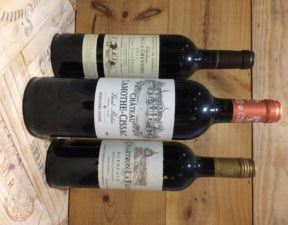For the average wine drinker Bordeaux can seem a bit of a minefield. There are no grape varieties on the labels. The quality of the wines change from year to year, due to the marginal climate there for the grapes to grow.
The marginal climate also means that traditionally vineyards were planted with a variety of grapes, as whatever the conditions hopefully some of the grapes would ripen,. The region is often put altogether, when in fact the region produces a huge variety of styles. I will hopefully be able to shine a light on the region with a few simple facts and help you choose the right Bordeaux for your taste, as decent Bordeaux is an excellent wine for cold wintery evenings and perfect match for seasonal food.
Right Bank and Left Bank
In simple terms the region is split in half by the Gironde estuary and the rivers that lead into it. The north side of this is the know as the ‘Right Bank’ and the south side as the ‘Left Bank’. The areas on each bank make in broad terms two different style of wines. This is due to the soil being different on each side and therefore more suitable for different types of grapes. This leads us into what actual grapes make up the wines within Bordeaux. The main grape varieties for red wine in Bordeaux are: Cabernet Sauvignon, Cabernet Franc and Merlot, which can also be supplemented in generally small amounts by Petit Verdot and Malbec. Each grape variety adds different flavours and characteristics to the wine. Thus, depending on where the wine is from in Bordeaux will determine the blend of grapes that make up the wine.
Right Bank Bordeaux
The soils here have generally higher clay content. This makes them more suitable for planting Merlot. Merlot gives the wines soft and rich fruit. To give these wines structure, Cabernet Franc is added in to the blend, which help the wine get better as it ages. The right bank has two key areas (appellations) for top Bordeaux: Pomerol and Saint-Emillion. There are other appellations which make similar wines, for a fraction of the price.
Left Bank Bordeaux
The soils here have a high gravel content. The gravel retains heat and helps with drainage, this makes the soil perfect for Cabernet Sauvignon, as this grape would otherwise struggle to ripen. Therefore, these wines generally have a greater portion of Cabernet Sauvignon, with some Merlot to soften the wines a touch. The top appellations are: Pauillac, Saint-Estephe, Saint-Julien, Margaux and Pessac-Leognan. The area round the top appellations is generically known as the “Medoc” or “Graves” .
Three wines to start you off
Right Bank: Chateau De La Greniere 2011 Lussac St-Emillion –Soft fruit and delicate spice make this an excellent match for a simple roast. £14.99
Left Bank: Chateau Lamothe Cissac 2008 Haut-Medoc – Black fruit and some tannin makes this a good match for game and a good cheese board. £16.99
Introduction to Bordeaux: Chartron La Fleur 2012 Bordeaux – Entry level Bordeaux made from Merlot and Cabernet Sauvignon sourced from throughout the region. £8.99
For three weekends from the 18th of November we will have a couple of Bordeaux open to try in store, so do stop by to try the wines.

